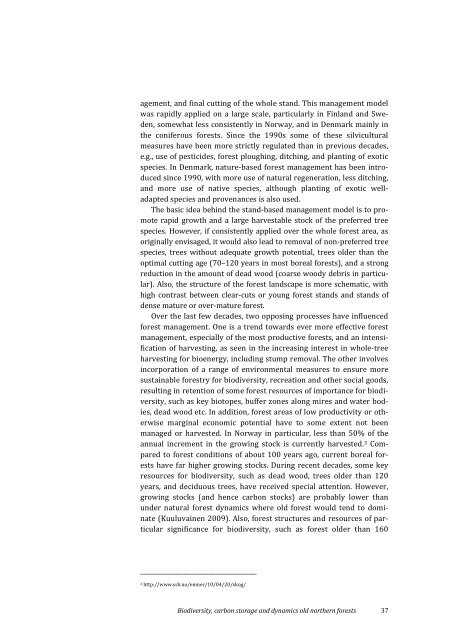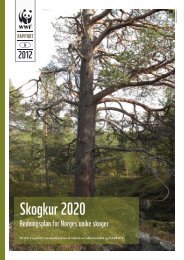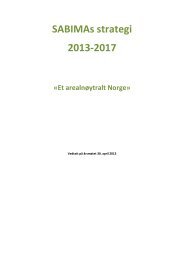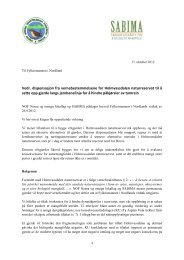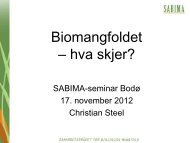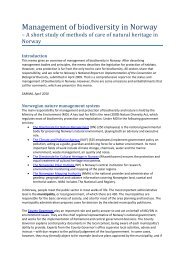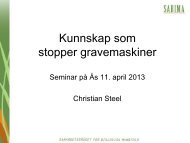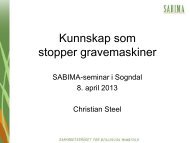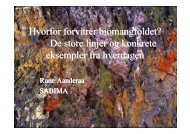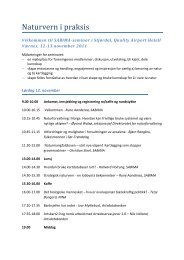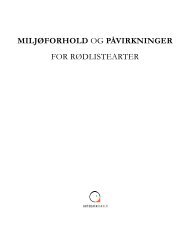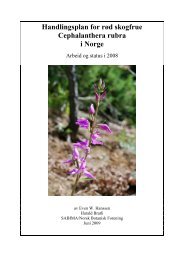Biodiversity, carbon storage and dynamics of old northern ... - BPAN.fi
Biodiversity, carbon storage and dynamics of old northern ... - BPAN.fi
Biodiversity, carbon storage and dynamics of old northern ... - BPAN.fi
You also want an ePaper? Increase the reach of your titles
YUMPU automatically turns print PDFs into web optimized ePapers that Google loves.
agement, <strong>and</strong> <strong>fi</strong>nal cutting <strong>of</strong> the whole st<strong>and</strong>. This management model<br />
was rapidly applied on a large scale, particularly in Finl<strong>and</strong> <strong>and</strong> Sweden,<br />
somewhat less consistently in Norway, <strong>and</strong> in Denmark mainly in<br />
the coniferous forests. Since the 1990s some <strong>of</strong> these silvicultural<br />
measures have been more strictly regulated than in previous decades,<br />
e.g., use <strong>of</strong> pesticides, forest ploughing, ditching, <strong>and</strong> planting <strong>of</strong> exotic<br />
species. In Denmark, nature-based forest management has been introduced<br />
since 1990, with more use <strong>of</strong> natural regeneration, less ditching,<br />
<strong>and</strong> more use <strong>of</strong> native species, although planting <strong>of</strong> exotic welladapted<br />
species <strong>and</strong> provenances is also used.<br />
The basic idea behind the st<strong>and</strong>-based management model is to promote<br />
rapid growth <strong>and</strong> a large harvestable stock <strong>of</strong> the preferred tree<br />
species. However, if consistently applied over the whole forest area, as<br />
originally envisaged, it would also lead to removal <strong>of</strong> non-preferred tree<br />
species, trees without adequate growth potential, trees <strong>old</strong>er than the<br />
optimal cutting age (70–120 years in most boreal forests), <strong>and</strong> a strong<br />
reduction in the amount <strong>of</strong> dead wood (coarse woody debris in particular).<br />
Also, the structure <strong>of</strong> the forest l<strong>and</strong>scape is more schematic, with<br />
high contrast between clear-cuts or young forest st<strong>and</strong>s <strong>and</strong> st<strong>and</strong>s <strong>of</strong><br />
dense mature or over-mature forest.<br />
Over the last few decades, two opposing processes have influenced<br />
forest management. One is a trend towards ever more effective forest<br />
management, especially <strong>of</strong> the most productive forests, <strong>and</strong> an intensi<strong>fi</strong>cation<br />
<strong>of</strong> harvesting, as seen in the increasing interest in whole-tree<br />
harvesting for bioenergy, including stump removal. The other involves<br />
incorporation <strong>of</strong> a range <strong>of</strong> environmental measures to ensure more<br />
sustainable forestry for biodiversity, recreation <strong>and</strong> other social goods,<br />
resulting in retention <strong>of</strong> some forest resources <strong>of</strong> importance for biodiversity,<br />
such as key biotopes, buffer zones along mires <strong>and</strong> water bodies,<br />
dead wood etc. In addition, forest areas <strong>of</strong> low productivity or otherwise<br />
marginal economic potential have to some extent not been<br />
managed or harvested. In Norway in particular, less than 50% <strong>of</strong> the<br />
annual increment in the growing stock is currently harvested. 3 Compared<br />
to forest conditions <strong>of</strong> about 100 years ago, current boreal forests<br />
have far higher growing stocks. During recent decades, some key<br />
resources for biodiversity, such as dead wood, trees <strong>old</strong>er than 120<br />
years, <strong>and</strong> deciduous trees, have received special attention. However,<br />
growing stocks (<strong>and</strong> hence <strong>carbon</strong> stocks) are probably lower than<br />
under natural forest <strong>dynamics</strong> where <strong>old</strong> forest would tend to dominate<br />
(Kuuluvainen 2009). Also, forest structures <strong>and</strong> resources <strong>of</strong> particular<br />
signi<strong>fi</strong>cance for biodiversity, such as forest <strong>old</strong>er than 160<br />
──────────────────────────<br />
3 http://www.ssb.no/emner/10/04/20/skog/<br />
<strong>Biodiversity</strong>, <strong>carbon</strong> <strong>storage</strong> <strong>and</strong> <strong>dynamics</strong> <strong>old</strong> <strong>northern</strong> forests 37


